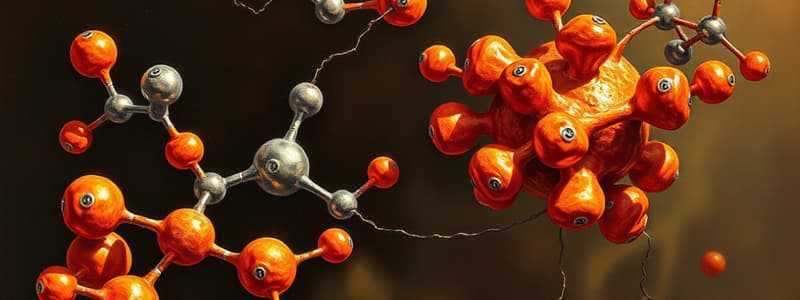Podcast
Questions and Answers
What type of molecule is Molecule A categorized as?
What type of molecule is Molecule A categorized as?
- Carbohydrate (correct)
- Lipid (correct)
- Nucleic acid (correct)
- Protein (correct)
In plants, glucose is stored in the form of which compound?
In plants, glucose is stored in the form of which compound?
- Chitin
- Starch (correct)
- Glycogen
- Cellulose
Which of the following represents a carbohydrate?
Which of the following represents a carbohydrate?
- Sucrose (correct)
- Steroid
- ATP
- Waxes
What characterizes lipids among other biomolecules?
What characterizes lipids among other biomolecules?
Which of the following is NOT an example of a lipid?
Which of the following is NOT an example of a lipid?
Long chains of carbon and hydrogen are most closely related to which biomolecule?
Long chains of carbon and hydrogen are most closely related to which biomolecule?
What defines the unique properties of an amino acid?
What defines the unique properties of an amino acid?
Which biomolecule is primarily responsible for storing genetic information?
Which biomolecule is primarily responsible for storing genetic information?
Which bond connects the two strands of a DNA molecule?
Which bond connects the two strands of a DNA molecule?
What process occurs when paper burns and combines with oxygen?
What process occurs when paper burns and combines with oxygen?
Flashcards
Molecule Classification
Molecule Classification
A molecule identified as carbohydrate, lipid, nucleic acid, or protein.
Plant Glucose Storage
Plant Glucose Storage
Plants store glucose as starch.
Lipid Characteristics
Lipid Characteristics
Insoluble in water, used for energy storage.
Lipid Association
Lipid Association
Signup and view all the flashcards
Protein Structure
Protein Structure
Signup and view all the flashcards
Nucleic Acid types
Nucleic Acid types
Signup and view all the flashcards
DNA Function
DNA Function
Signup and view all the flashcards
Nucleotide Structure
Nucleotide Structure
Signup and view all the flashcards
ATP Energy Storage
ATP Energy Storage
Signup and view all the flashcards
Study Notes
Classification of Molecules
- Molecule A is identified as a carbohydrate, lipid, nucleic acid, or protein.
- Plants store glucose primarily in the form of starch, not glycogen, cellulose, or chitin.
Carbohydrates and Their Examples
- Sucrose is classified as a carbohydrate, whereas ATP, steroids, and wax are not.
Characteristics of Lipids
- Lipids are insoluble in water and are utilized by the body for energy storage.
- Examples of lipids include oil, steroids, and candle wax; starch is not considered a lipid.
Relationship Between Molecules
- Lipids are closely associated with long chains of carbon and hydrogen.
- Proteins are closely linked to amino acids, distinguishing them from monosaccharides and sugars.
Protein Structure and Formation
- Proteins contain long chains of amino acids, forming their primary structure, secondary structure, tertiary structure, or quaternary structure.
- The connection between amino acids involves a peptide bond, linking one amino group to another's carboxyl group.
Nucleic Acids
- The two primary types of nucleic acids are DNA and RNA.
- Nucleotides are the fundamental building blocks of nucleic acids.
- Nucleic acids are closely related to amino acids and sugars.
DNA and Its Function
- DNA serves the function of storing hereditary information, distinct from storing fat, energy, or carbohydrates.
- The double strands of a DNA molecule are bonded together by hydrogen bonds, differentiating them from ionic or peptidic bonds.
Structure of Nucleotides
- A nucleotide in a DNA molecule consists of a sugar, a phosphate group, and a nitrogenous base. It does not contain three phosphate groups.
Energy Storage in ATP
- ATP (adenosine triphosphate) stores energy specifically in the bonds between phosphate groups, not hydrogen or carbon atoms.
Mass Comparison in Combustion
- When paper burns, the mass of the resulting carbon dioxide and water vapor is identical to the combined mass of the original paper and oxygen, demonstrating the conservation of mass.
Studying That Suits You
Use AI to generate personalized quizzes and flashcards to suit your learning preferences.




